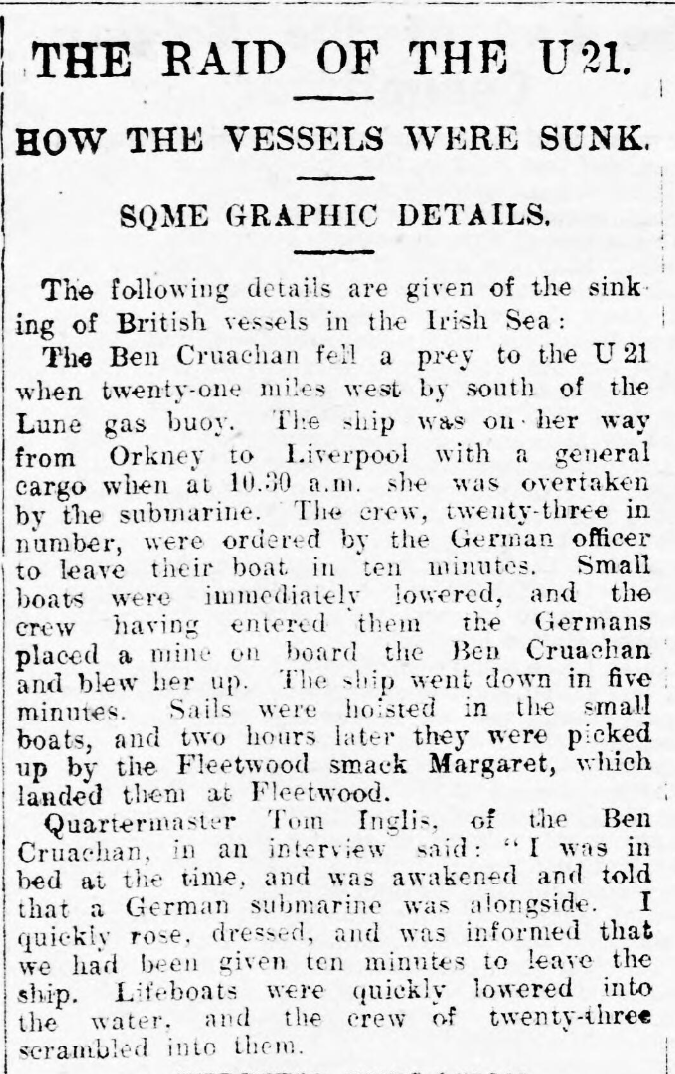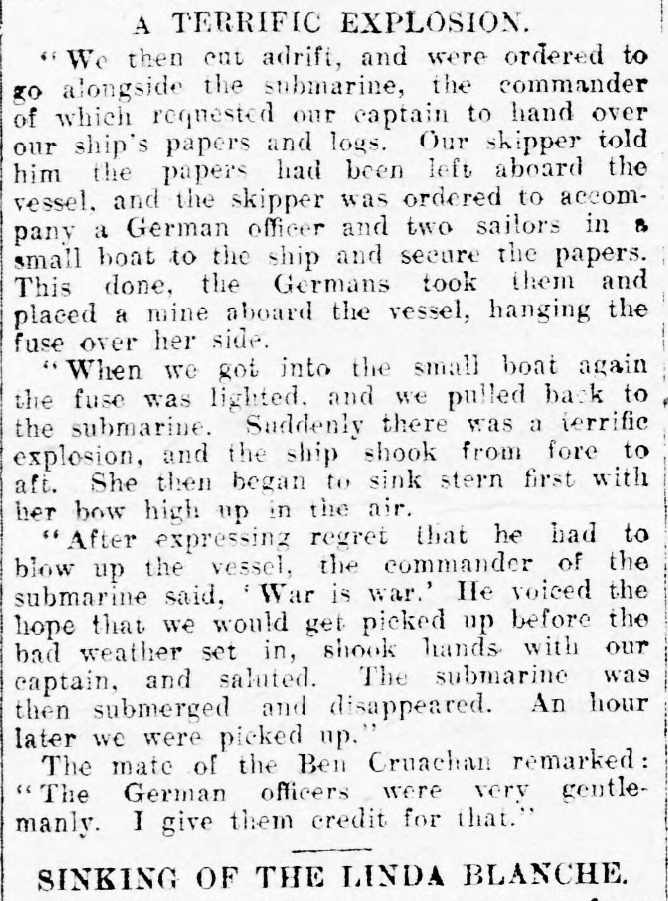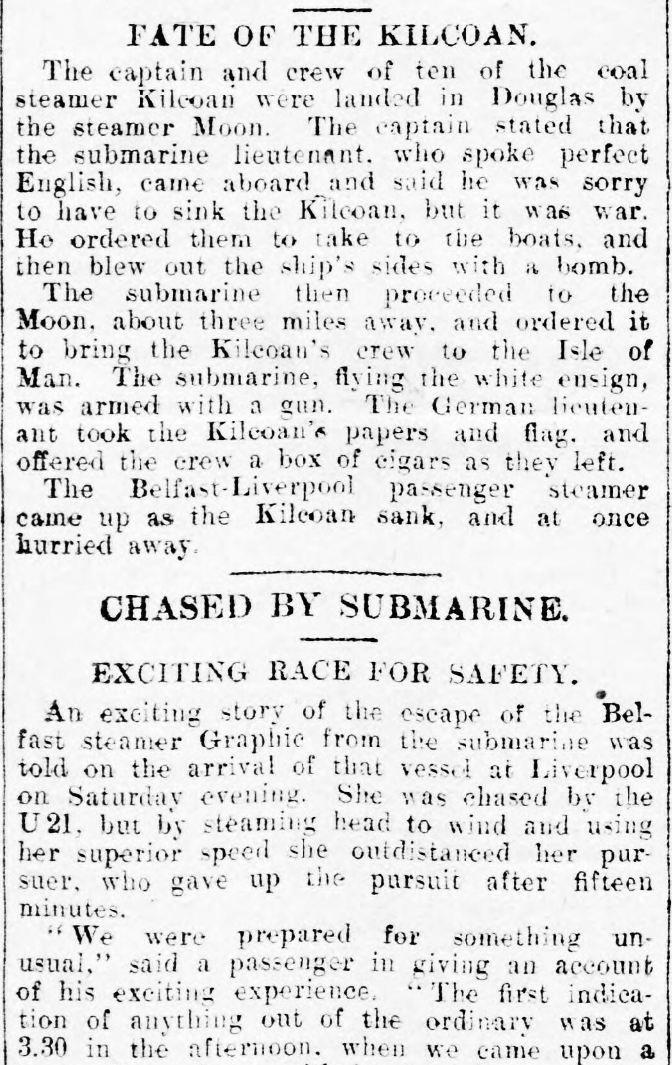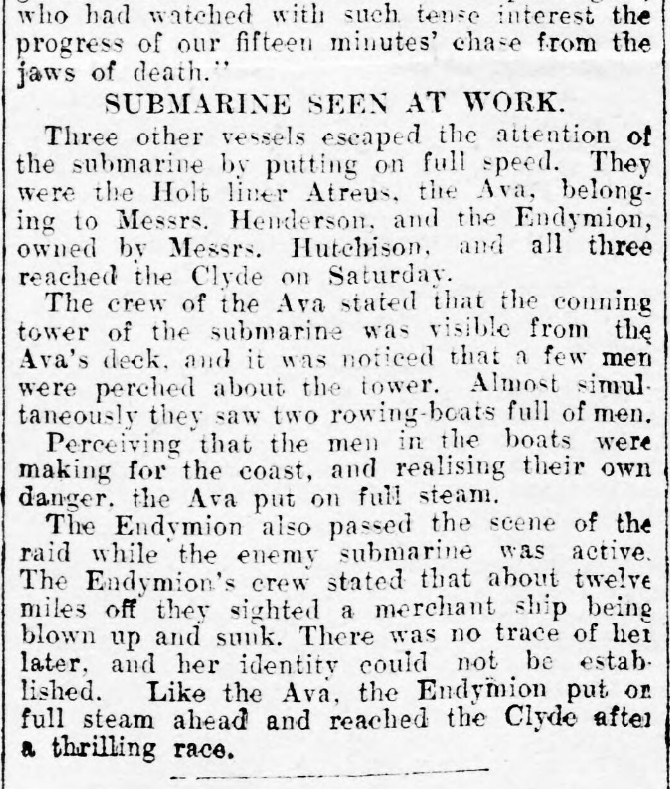Gellir lawrlwytho cynnwys at ddefnydd anfasnachol, megis defnydd personol neu ar gyfer adnoddau addysgol.
Ar gyfer defnydd masnachol cysyllwch yn uniongyrchol gyda deilydd yr hawlfraint os gwelwch yn dda.
Read more about the The Creative Archive Licence.
Disgrifiad
Dyddiad: 3 Chwefror 1915
Trawsysgrif:
IRISH SEA RAID.
THREE VESSELS lSUNK NEAR MERSEY.
Three smaller vessels were also sunk on Saturday in the Irish Sea, off the mouth of the Mersey, by the German submarine U21.
In these cases notice was given to the crew, who were allowed time to put off in their boats before their ships were sunk.
No further casualties are reported beyond these five, and sailings from Liverpool and other British ports are being continued as usual.
The submarine U 21 belongs to the latest class which Germany possesses, and has a range of some 2,000 miles.
In each case the submarine came up alongside, gave the crews ten minutes in which to take to their boats, and then shattered the ships by explosives placed on board.
The most serious loss is that of the Ben Cruachan, 3,092 tons, with coal from Cardiff. The Linda Blanche, of Anglesea, and the Kilcorn, of Liverpool, both small colliers of under 500 tons, were the other victims.
A ship's captain on arrival at Fleetwood reported having seen a large steamer blown up, but it was uncertain as yet whether this represented a fourth loss, or was one of the vessels already accounted for.
THE RAID OF THE U21
HOW THE VESSELS WERE SUNK.
SOME GRAPHIC DETAILS.
The following details are given of the sinking of British vesels in the Irish Sea:
The Ben Cruachan fell a prey to the U 21 when twenty-one miles west by south of the Lune gas buoy. The ship was on her way from Orkney to Liverpool with a general cargo when at 10.30 a.m. she was overtaken by the submarine. The crew, twenty-three in number, were ordered by the German officer to leave their boat in ten minutes. Small boats were immediately lowered, and the crew having entered them the Germans placed a mine on board the Ben Cruachan and blew her up. The ship went down in five minutes. Sails were hoisted in the small boats, and two hours later they were picked up by the Fleetwood smack Margaret, which landed them at Fleetwood.
Quartermaster Tom Inglis, of the Ben Cruachan, in an interview said: "I was in bed at the time, and was awakened and told that a German submarine was alongside. I quickly rose, dressed, and was informed that we had been given ten minutes to leave the ship. Lifeboats were quickly lowered into the water, and the crew of twenty-three scrambled into them.
A TERRIFIC EXPLOSION.
"We then cut adrift, and were ordered to go alongside the submarine, the commander of which requested our captain to hand over our ship's papers and logs. Our skipper told him the papers bad been left aboard the vessel, and the skipper was ordered to accompany a German officer and two sailors in a small boat to the ship and secure the papers. This done, the Germans took them and placed a mine aboard the vessel, hanging the fuse over her side.
"When we got into the small boat again the fuse was lighted, and we pulled back to the submarine. Suddenly there was a terrific explosion, and the ship shook from fore to aft. She then began to sink stern first with her bow high up in the air.
"After expressing regret that he had to blow up the vessel, the commander of the submarine said, 'War is war.' He voiced the hope that we would get picked up before the bad weather set in, shook hands with our captain, and saluted. The submarine was then submerged and disappeared. An hour later we were picked up."
The mate of the Ben Cruachan remarked: "The German officers were very gentlemanly. I give them credit for that."
SINKING OF THE LINDA BLANCHE.
The Linda Blanche was on a voyage from Manchester to Belfast with a general cargo. She left Manchester at four o'clock on Friday afternoon, and anchored in the Mersey.
At eight o'clock on Saturday morning, the voyage was resumed, and at 12.30 p.m., when the vessel was due west of Liverpool Lightship, the German submarine U 21 came alongside suddenly, and, hoisting the German flag, boarded the vessel.
CIGARS FOR THE CREW.
The German officers, who spoke perfect English, instructed the skipper, Captain Ellis, to take the crew off within ten minutes. The two small boats of the vessel were quickly lowered, and the crew, who numbered ten, got into them.
The German sailors then fixed a mi ne on the bridge of the vessel and another on the forecastle, and these exploded. The vessel was a complete wreck in five minutes.
The Germans told the crew there was a trawler in a certain direction, and at two o'clock they were picked up by it and landed at Fleetwood.
In their haste to get into the boat the captain's fox terrier was overlooked, and when the crew had cleared off the dog jumped into the sea and swam to the small boat.
One of the crew said the Germans were very considerate. They gave them a box of cigars and inquired whether they had plenty of water in the boats.
FATE OF THE KILCOAN.
The captain and crew of ten of the coal steamer Kilcoan were landed in Douglas by the steamer Moon. The captain stated that, the submarine lieutenant, who spoke perfect English, came aboard and said he was sorry to have to sink the Kilcoan, but it was war. He ordered them to take to the boats, and then blew out the ship's sides with a bomb.
The submarine then proceeded to the Moon, about three miles away, and ordered it to bring the Kilcoan's crew to the Isle of Man. The submarine, flying the white ensign, was armed with a gun. The German lieutenant took the Kilcoan's papers and flag, and offered the crew a box of cigars as they Ieft.
The Belfast-Liverpool passenger steamer came up as the Kilcoan sank, and at once hurried away.
CHASED BY SUBMARINE.
EXCITING RACE FOR SAFETY.
An exciting story of the escape of the Belfast steamer Graphic from the submarine was told on the arrival of that vessel at Liverpool on Saturday evening. She vas chased by the U 21, but by steaming head to wind and using her superior speed she outdistanced her pursuer, who gave up the pursuit after fifteen minutes.
''We were prepared for something unusual," said a passenger in giving an account of his exciting experience. "'The first indication of anything out of the ordinary was at 3.30 in the afternoon, when we came upon a mass of wreckage, with hundreds of barrels of oil, floating sides of bacon, and casks bobbing up and down en the waves. Then we saw a three-masted vessel with one funnel, apparently in some difficulty. She seemed to fall a little over to her side, and a few moments later she gave a lurch and went down. It was then seen that a little, grey, sinister-looking warship, which we were told was a submarine, was only a short distance away.
LIFEBELTS SERVED OUT.
"At once the captain ordered lifebelts to be served out to every passenger, but there was no panic. The Graphic changed her course with her head to the wind, and I was told this was done because the submarine would be swamped if she tried to follow us with a good sea on. We saw the submarine follow, but she soon gave up and disappeared."
A lady passenger on the Graphic said:
"There were about 100 passengers and forty crew on the little steamer. As soon as the submarine was sighted, the Graphic changed her course and went in almost the opposite direction to Liverpool. The grim little submarine, low-lying on the surface of the water, came on after us, and the sea was washing over her, showing the speed with which she was coming, but we were always equal to her.
"Our engine staff was doubled, and it was a case of all hands to the fires. They stoked away like fury, and the Graphic pushed on at a splendid rate. We gradually got ahead of her, and when she disappeared from view altogether there was a cheer from the passengers, who had watched with such interest the progress of our fifteen minutes' chase from the jaws of death."
SUBMARINE SEEN AT WORK.
Three other vessels escaped the attention of the submarine by putting on full speed. They were the Holt liner Atreus, the Ava, belonging to Messrs. Henderson, and the Endymion, owned by Messrs. Hutchinson, and all three reached the Clyde on Saturday.
The crew of the Ava stated that the conning tower of the submarine was visible from the Ava's deck, and it was noticed that a few men were perched about the tower. Almost simultaneously they saw two rowing-boats full of men.
Perceiving that the men in the boats wer making for the coast, and realising their own danger, the Ava put on full steam.
The Endymion also passed the scene of the raid while the enemy submarine was active. The Endymion's crew stated that about twelve miles off they sighted a merchant ship being blown up and sunk. There was no trace of her later, and her identity could not be established. Like the Ava, the Endymion put on full steam ahead and reached the Clyde after a thrilling race.
ffynhonell:
"IRISH SEA RAID", "THE RAID OF THE U21." Haverfordwest and Milford Haven Telegraph and General Weekly Reporter for the Counties of Pembroke, Cardigan, Carmarthen, Glamorgan and the Rest of South Wales. 3 Chwefror 1915. 4.

















Oes gennych chi wybodaeth ychwanegol am yr eitem hon? Gadewch sylwad isod
Sylwadau (0)
Rhaid mewngofnodi i bostio sylw